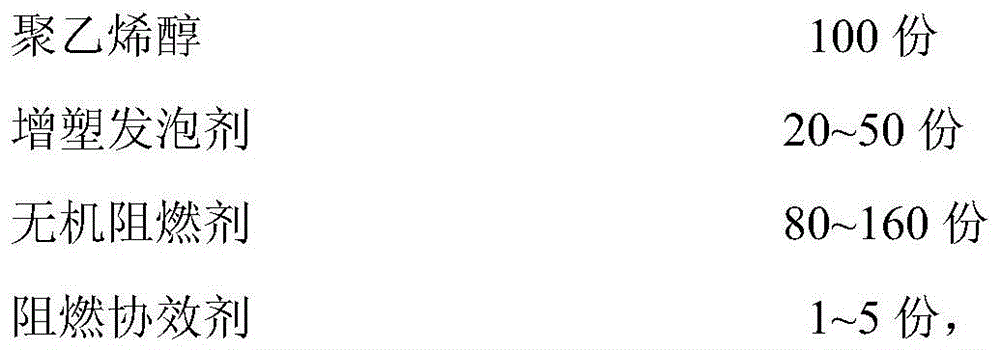High-fill high-heat-resistance polyvinyl alcohol-based microcellular foam type flame retardant paper and thermoplastic processing method thereof
A technology of polyvinyl alcohol and processing method, which is applied in the field of flame-retardant paper and its preparation, can solve problems such as discontinuity, natural hazards, and poor environmental protection, and achieve excellent mechanical properties and antistatic properties, continuous industrial production, and good barrier properties performance effect
- Summary
- Abstract
- Description
- Claims
- Application Information
AI Technical Summary
Problems solved by technology
Method used
Image
Examples
Embodiment 1
[0043] 100 parts of polyvinyl alcohol with a degree of polymerization of 1700 and a degree of alcoholysis of 99%, and 40 parts of plasticizing foaming agent (water: pentaerythritol = 3: 1) were mixed evenly, and the swelling of polyvinyl alcohol was completely increased at room temperature. Plastic polyvinyl alcohol particles, then mix it with 160 parts of hydrotalcite and 1 part of melamine polyphosphate in a high-speed mixer to obtain a composite powder; put the obtained composite powder into a screw extruder for extrusion, cooling and traction , flattened, coiled. The melting section temperature is 180°C, the die section temperature is 140°C, the extrusion rotation speed is 10rpm, and the pulling speed is 30rpm.
[0044] The vertical combustion of the obtained flame-retardant paper material reaches UL94V-0 level, the limiting oxygen index reaches 38%, the tensile strength is 1.0MPa, and the apparent density is 0.50g / cm 3 , the average cell diameter is 200μm, and the thickn...
Embodiment 2
[0046] Mix 100 parts of polyvinyl alcohol with a degree of polymerization of 1700 and a degree of alcoholysis of 99%, and 30 parts of plasticizing foaming agent (water), and make the polyvinyl alcohol swell completely at room temperature to obtain plasticized polyvinyl alcohol particles. Then mix it with 90 parts of magnesium hydroxide and 1 part of melamine polyphosphate in a high-speed mixer to obtain a composite powder; put the obtained composite powder into a screw extruder for extrusion, cooling and traction, flattening, rolling around. The melting section temperature is 175°C, the die section temperature is 115°C, the extrusion rotation speed is 40rpm, and the pulling speed is 30rpm.
[0047] The vertical combustion of the obtained flame-retardant paper material reaches UL94V-0 level, the limiting oxygen index reaches 36%, the tensile strength is 3.8MPa, and the apparent density is 0.27g / cm 3 , the average cell diameter is 130μm, and the thickness is 0.35mm.
Embodiment 3
[0049] 100 parts of polyvinyl alcohol with a degree of polymerization of 1700 and a degree of alcoholysis of 99%, and 40 parts of plasticizing foaming agent (water: glycerol = 4: 1) were mixed evenly, and the swelling of polyvinyl alcohol was completely increased at room temperature. Plastic polyvinyl alcohol particles, then mix it with 150 parts of magnesium hydroxide and 5 parts of melamine polyphosphate in a high-speed mixer to obtain a composite powder; put the obtained composite powder into a screw extruder for extrusion and cooling Traction, flattening, winding. The melting section temperature is 175°C, the die section temperature is 110°C, the extrusion rotation speed is 30rpm, and the pulling speed is 50rpm.
[0050] The vertical combustion of the obtained flame-retardant paper material reaches UL94V-0 level, the limiting oxygen index reaches 41%, the tensile strength is 3.0MPa, and the apparent density is 0.18g / cm 3 , The average cell diameter is 85μm, and the thickn...
PUM
| Property | Measurement | Unit |
|---|---|---|
| tensile strength | aaaaa | aaaaa |
| density | aaaaa | aaaaa |
| thickness | aaaaa | aaaaa |
Abstract
Description
Claims
Application Information
 Login to View More
Login to View More - R&D
- Intellectual Property
- Life Sciences
- Materials
- Tech Scout
- Unparalleled Data Quality
- Higher Quality Content
- 60% Fewer Hallucinations
Browse by: Latest US Patents, China's latest patents, Technical Efficacy Thesaurus, Application Domain, Technology Topic, Popular Technical Reports.
© 2025 PatSnap. All rights reserved.Legal|Privacy policy|Modern Slavery Act Transparency Statement|Sitemap|About US| Contact US: help@patsnap.com


